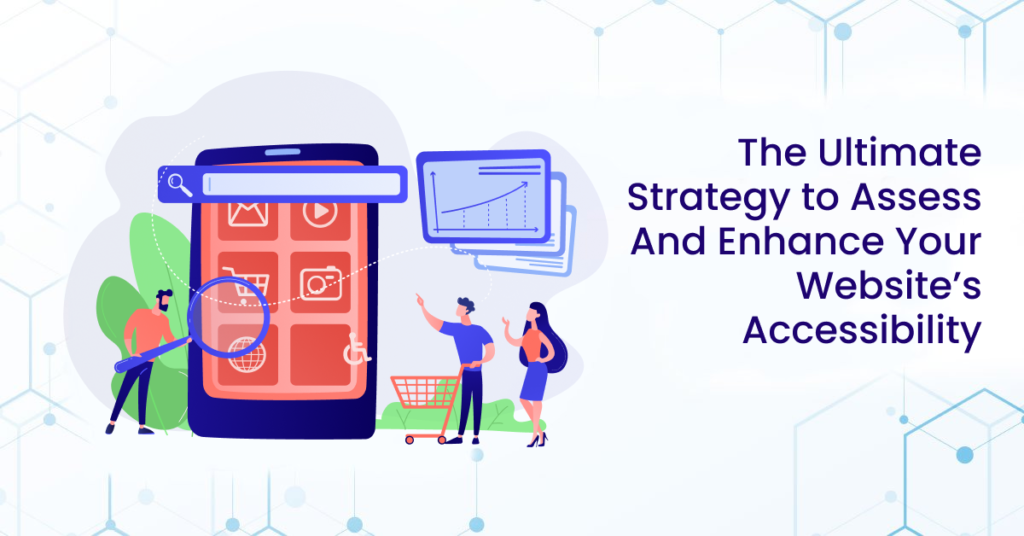In the USA the percentage of people who have internet access increased from 43% in 2000 to 91.8% in 2023. Couple this with the fact that 1 in 4 people in the USA have some sort of disability, investing in digital accessibility becomes not only an ethical practice but rather a strategic business necessity to compete in the market and increase user base.
If you are not aware of digital accessibility, it is in essence a practice of creating digital assets (Websites, WebApps, Documents, etc.) in a way that all users can navigate and interact with them irrespective of their disabilities. Let’s say your website cannot be navigated just by using a keyboard (keyboard-friendly), then all the users who are unable to use a mouse for whatever reason are excluded from accessing your website. It becomes even more important for E-commerce businesses as an inaccessible website would mean losing out on potential customers. Moreover, making your website accessible also ensures that you comply with legal requirements and mitigate the risk of lawsuits.
Laws like the Americans with Disabilities Act (ADA) and Section 508 legally demand websites to be accessible to all users in the USA. The current business practice is to invest in accessibility only after a lawsuit is filed against them. This becomes a very expensive and time-consuming process as businesses not only have to deal with the lawsuit but also haphazardly try to make their digital assets accessible which leaves many loose ends, increasing chances for future lawsuits. A better practice would be to think about accessibility from the beginning as it not only creates an inclusive website but also minimizes the chances of future legal complications.
The Business Case for Accessibility
Beyond legal obligations, businesses should view accessibility as a strategic investment. An accessible website broadens the customer base, fostering inclusivity and enhancing the user experience for everyone. Moreover, accessible design often leads to more straightforward, cleaner interfaces that benefit all users, not just those with disabilities. You can learn more about the business case for web accessibility in one of our blogs.
Ready to unlock the power of accessibility for your business but are confused about where to start? Don’t worry, we are here to guide you in the process. We have created a roadmap, divided into three phases, to simplify assessing and enhancing accessibility for your website.
Phase 1: Assessing the Current State of Accessibility
Now that the importance of accessibility is clear, the next step is to evaluate the current state of your website.
Conduct Automated Accessibility Tests
Utilize online tools and software that automatically scan your website for common accessibility issues. These tools can highlight areas needing attention, such as missing alt text for images or improper heading structures. Some popular automated testing tools include AXE, WAVE, A11y Toolkit, etc.
Perform Manual Testing
Automated tools may only catch some issues, especially those related to user experience. Manual testing involves navigating your site using screen readers, keyboard-only navigation, and other assistive technologies. This hands-on approach provides valuable insights into the user journey. Our certified accessibility experts conduct thorough checks to ensure that all the accessibility issues are addressed.
Get User Feedback
Actively seek feedback from users with disabilities. Engage with advocacy groups and communities, encouraging them to share their experiences with your website. You should also check your support tickets to look for accessibility-related issues. Firsthand insights can uncover issues that automated tools might miss.
Phase 2: Implementing Improvements
Identifying issues is only the first step. Once you understand the accessibility landscape, it’s time to implement improvements:
Prioritize Fixes
Categorize issues based on severity and prioritize fixes accordingly. Critical issues affecting core functionality or presenting significant barriers to access should take precedence.
Educate Teams
Foster a culture of accessibility within your organization. Educate content creators, designers, and developers about the importance of creating universally accessible digital content.
Hire an Accessibility Services Provider
Foster collaboration between accessibility experts and your developers. They play a pivotal role in executing code-level changes, modifying website elements, and ensuring optimal performance across various assistive technologies. Our team consists of accessibility developers adept at implementing fixes without changing your website’s UI.
Create Accessibility Statement
When you are putting effort into your accessibility initiatives, an accessibility statement is the best way to showcase your dedication. For products and services, a Voluntary Product Accessibility Template (VPAT) may be generated, providing detailed insights into compliance with accessibility standards.
Phase 3: Future Roadmap for Navigating Ongoing Web Accessibility
Web Accessibility is an ongoing commitment that adapts to shifting standards and technological advancements. To ensure sustained compliance and user satisfaction, consider the following:
Continuous Investment
Businesses should shift their perspective, recognizing that sustained investment in web accessibility is necessary for long-term compliance and user satisfaction. You should consider making accessibility an integral part of your budget to maintain consistency.
Strategic Partnership
To navigate this ongoing process seamlessly, consider partnering with a reliable Accessibility services provider on a retainer
Regular Monitoring
Ensure continuous compliance by regularly monitoring your digital assets against the latest accessibility standards.
Feedback Implementation
Leverage a proactive provider to swiftly implement user feedback, guaranteeing that your website remains genuinely accessible to all users.
Conclusion
Performing accessibility audits and implementing fixes following international accessibility standards like WCAG can be a complex and daunting task. Especially since failure to conform can result in a risk of lawsuits. It is better to delegate the task to accessibility professionals who are experts and well-versed in making digital assets inclusive. If you wish to start on your accessibility journey or if have been looking for an accessibility services provider to accelerate your ongoing efforts, our team of IAAP and DHS-certified experts can help you. We have proven experience in simplifying accessibility for organizations and helping maintain conformance.
Contact us today to learn more about our services and get a free accessibility audit for your website.

